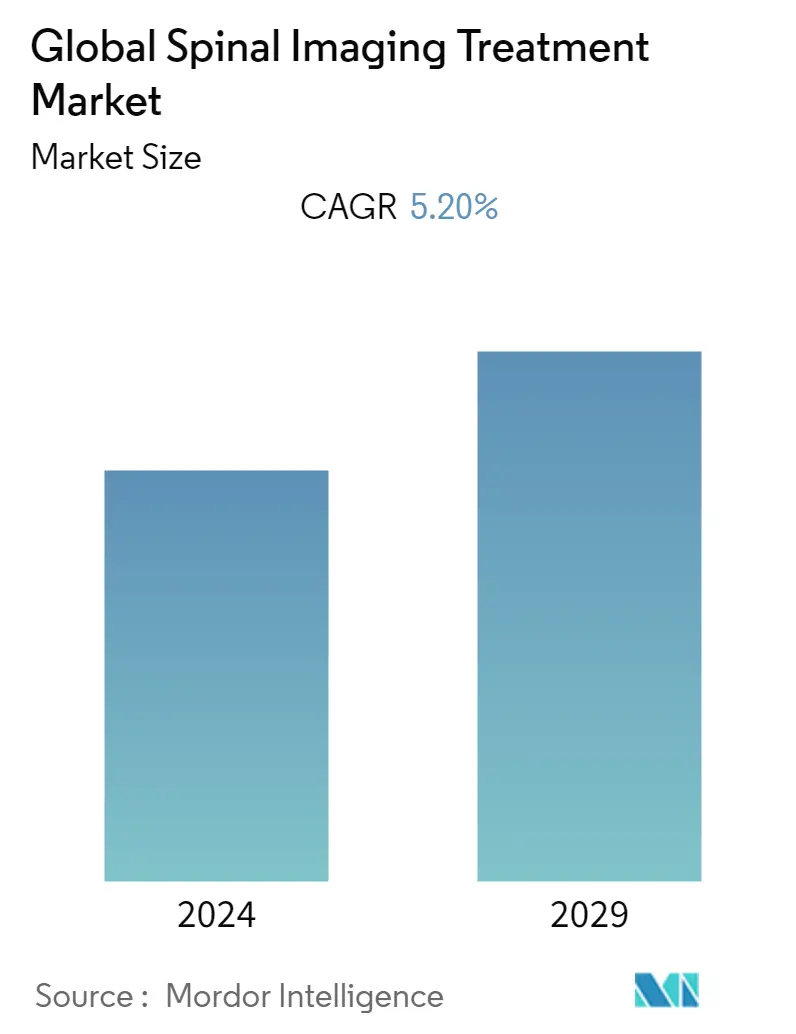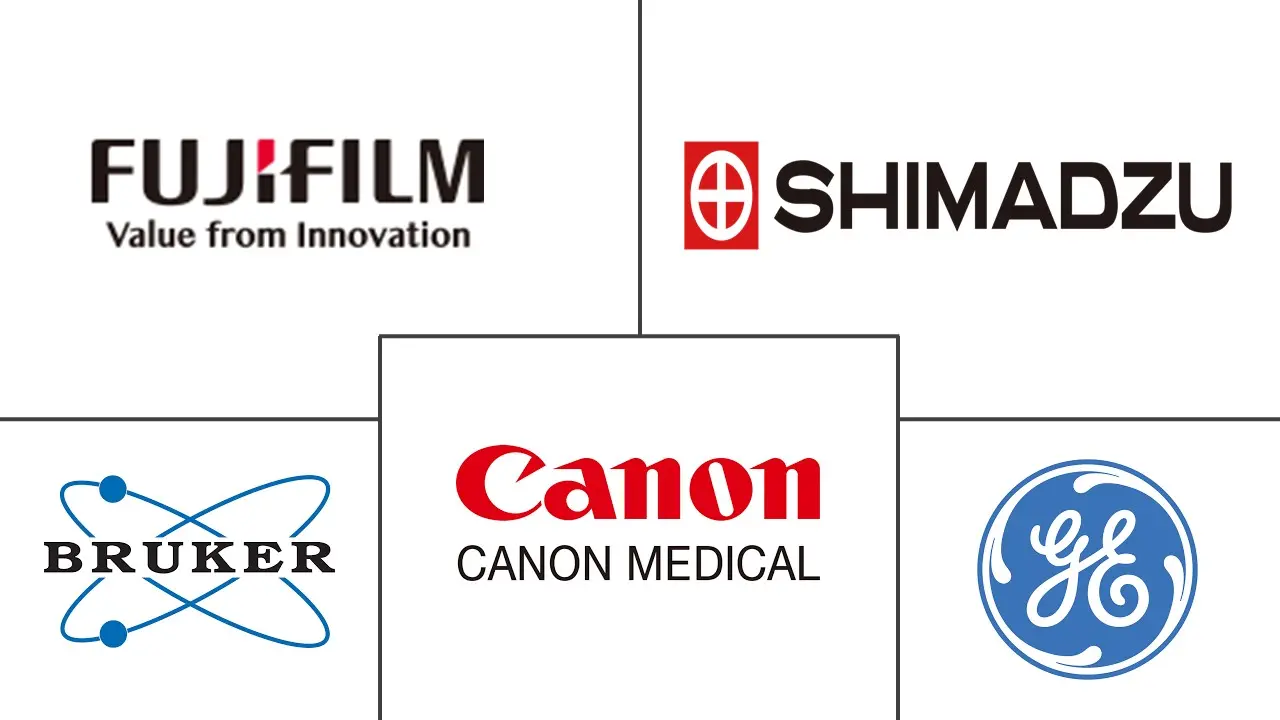Market Size of Global Spinal Imaging Treatment Industry

| Study Period | 2019 - 2029 |
| Base Year For Estimation | 2023 |
| CAGR | 5.20 % |
| Fastest Growing Market | Asia-Pacific |
| Largest Market | North America |
| Market Concentration | Medium |
Major Players
*Disclaimer: Major Players sorted in no particular order |
Spinal Imaging Treatment Market Analysis
The spinal imaging treatment market is expected to register a CAGR of nearly 5.2% over the forecast period (2022-2027).
The Covid-19 pandemic affected the demand for the spinal imaging market in 2020. During the early pandemic, the demand for spinal imaging had reduced due to the lockdown restrictions, suspension of non-urgent scheduled visits and hospitalizations, and stringent social distancing norms. For instance, the research study 'Radiological Manifestation of Neurological Complications in the Course of SARS-CoV-2 Infection" was Published in Frontier in Neurology in October 2021, one of the most crucial aspects of diagnosis is using radiological techniques to determine the cause of neurological symptoms linked to SARS-CoV-2 infection. Utilizing radiological imaging techniques to track the emergence of different symptoms is essential to determine the severity and extent of involvement, especially when there is nervous system involvement. Thus, the demand for spinal imaging has increased during COVID-19, however, declined patient visits to the imaging center may hamper the market growth.
Certain factors driving the market growth include the rising global burden of spinal disorders and the rising prevalence of spinal disorders, such as herniated disc, spinal stenosis, cauda equina syndrome, and radiculopathy, expected to drive the growth of the market. Developing patients' accessibility to medical imaging services and the growing procedural volume of spinal surgeries are further expected to boost the market growth. Moreover, according to the study 'Prevalence of Spine Degeneration Diagnosis by Type, Age, Gender, and Obesity Using Medicare Data' published in the Scientific Report in March 2021, Age was a factor in the prevalence of diagnosed spinal degenerative disease, which was 27.3 percent overall. Additionally, according to an article published by the National Center for Biotechnology Information, in 2021, titled 'Spinal Cord Injuries', stated that in the United States, there are approximately 17,000 new cases of spinal cord injuries (SCI) each year. Thus, the increasing prevalence of spinal degeneration and spinal cord injury is anticipated to boost the market growth.
Moreover, rising in the funding for the treatment of the spinal cord injury and diseases treatment from the various private and public sector organization is expected to accelerate the market growth. For instance, In January 2022, Researchers from UBC have taken the lead on a USD 24 million grant for the treatment of spinal cord injuries. Such initiatives supports the market expansion. Furthermore, market players are frequently launching new products and adopting various growth strategies in their respective segments, which is likely to drive market growth. For Instance, in September 2021, Konica Minolta Healthcare Americas, Inc. reported that Dynamic Digital Radiography (DDR) rapidly gaining acceptance in spine centers across the United States due to its ability to capture the physiological motion of the cervical spine (C-spine) and lumbar spine (L-spine) as a patient moves through the full range of motion.
Thus, all aforementioned factors is expected to drive the growth of the market over the forecast period. However, high cost associated with the imaging modality restraint the market growth.
Spinal Imaging Treatment Industry Segmentation
As per the scope of the reports, spinal imaging is used to detect any abnormality in the spinal area which can cause problems such as low back pain, neck pain, numbness, tingling, and weakness in your arms and legs. The Spinal Imaging Treatment Market is segmented By Product (X-ray, CT, MRI, Ultrasound), Application (Spinal Infection, Vertebral Fractures, Spinal Cancer), End User (Hospitals, Diagnostic Imaging Center, Ambulatory Care Center) and Geography (North America, Europe, Asia-Pacific, Middle East and Africa, and South America). The market report also covers the estimated market sizes and trends for 17 different countries across major regions, globally. The report offers the value (in USD million) for the above segments.
| By Product Type | |
| X-ray | |
| CT scan | |
| MRI | |
| Ultrasound |
| By Application | |
| Spinal Infection | |
| Vertebral Fractures | |
| Spinal Cancer | |
| Spinal Cord and Nerve Compression |
| By End User | |
| Hospitals | |
| Diagnostic Imaging Center | |
| Ambulatory Care Center |
| Geography | ||||||||
| ||||||||
| ||||||||
| ||||||||
| ||||||||
|
Global Spinal Imaging Treatment Market Size Summary
The spinal imaging treatment market is poised for steady growth, driven by the increasing global burden of spinal disorders and advancements in imaging technologies. The market experienced a temporary decline in demand during the early stages of the Covid-19 pandemic due to lockdowns and reduced patient visits. However, the pandemic also highlighted the importance of radiological techniques in diagnosing neurological complications, which subsequently boosted demand. Factors such as the rising prevalence of conditions like herniated discs, spinal stenosis, and spinal cord injuries are expected to propel market expansion. Additionally, improved access to medical imaging services and the growing volume of spinal surgeries contribute to the market's positive outlook. Despite the high costs associated with imaging modalities posing a challenge, the market is supported by increased funding for spinal cord injury treatments and the introduction of innovative products by key players.
North America dominates the spinal imaging market, driven by high demand for advanced healthcare technologies and a significant number of vertebral surgeries. The region's market growth is further supported by extensive investments in research and development, along with the availability of advanced diagnostic devices. The prevalence of spinal cord diseases and injuries in the United States underscores the need for effective imaging solutions. Companies in the region are actively engaging in strategic initiatives such as product launches, mergers, and acquisitions to maintain their market positions. The competitive landscape features major players like GE Healthcare, Siemens Healthineers, and Philips, alongside emerging companies introducing new technologies. These dynamics, coupled with technological advancements in MRI and other imaging modalities, are expected to drive the market's growth trajectory over the forecast period.
Global Spinal Imaging Treatment Market Size - Table of Contents
-
1. MARKET DYNAMICS
-
1.1 Market Overview
-
1.2 Market Drivers
-
1.2.1 Rise in the incidences of spinal disorders
-
1.2.2 Rise in the funds by private and public sector
-
1.2.3 Technological advancements.
-
-
1.3 Market Restraints
-
1.3.1 High cost associated with imaging modalities
-
-
1.4 Porter's Five Forces Analysis
-
1.4.1 Threat of New Entrants
-
1.4.2 Bargaining Power of Buyers/Consumers
-
1.4.3 Bargaining Power of Suppliers
-
1.4.4 Threat of Substitute Products
-
1.4.5 Intensity of Competitive Rivalry
-
-
-
2. MARKET SEGMENTATION (Market Size by Value - USD million)
-
2.1 By Product Type
-
2.1.1 X-ray
-
2.1.2 CT scan
-
2.1.3 MRI
-
2.1.4 Ultrasound
-
-
2.2 By Application
-
2.2.1 Spinal Infection
-
2.2.2 Vertebral Fractures
-
2.2.3 Spinal Cancer
-
2.2.4 Spinal Cord and Nerve Compression
-
-
2.3 By End User
-
2.3.1 Hospitals
-
2.3.2 Diagnostic Imaging Center
-
2.3.3 Ambulatory Care Center
-
-
2.4 Geography
-
2.4.1 North America
-
2.4.1.1 United States
-
2.4.1.2 Canada
-
2.4.1.3 Mexico
-
-
2.4.2 Europe
-
2.4.2.1 United kingdom
-
2.4.2.2 Germany
-
2.4.2.3 France
-
2.4.2.4 Italy
-
2.4.2.5 Spain
-
2.4.2.6 Rest of Europe
-
-
2.4.3 Asia-Pacific
-
2.4.3.1 China
-
2.4.3.2 India
-
2.4.3.3 Japan
-
2.4.3.4 Australia
-
2.4.3.5 South Korea
-
2.4.3.6 Rest of Asia-Pacific
-
-
2.4.4 Middle East and Africa
-
2.4.4.1 GCC
-
2.4.4.2 South Africa
-
2.4.4.3 Rest of Middle East and Africa
-
-
2.4.5 South America
-
2.4.5.1 Brazil
-
2.4.5.2 Argentina
-
2.4.5.3 Rest of South America
-
-
-
Global Spinal Imaging Treatment Market Size FAQs
What is the current Global Spinal Imaging Treatment Market size?
The Global Spinal Imaging Treatment Market is projected to register a CAGR of 5.20% during the forecast period (2024-2029)
Who are the key players in Global Spinal Imaging Treatment Market?
GE Healthcare, Bruker, Canon Medical Systems, Fujifilm Corporation and Shimadzu Corporation are the major companies operating in the Global Spinal Imaging Treatment Market.

